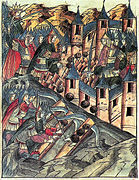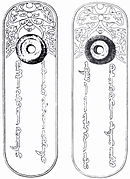ഗോൾഡൻ ഹോർഡ്
Golden Horde Ulus of Jochi[a] Зүчийн улс | |
|---|---|
| 1240s–1502 | |
 | |
| പദവി |
|
| തലസ്ഥാനം | Sarai Batu |
| പൊതുവായ ഭാഷകൾ | |
| മതം |
|
| ഗവൺമെൻ്റ് | Semi-elective monarchy, later hereditary monarchy |
• 1226–1280 | Orda Khan (White Horde) |
• 1242–1255 | Batu Khan (Blue Horde) |
• 1379–1395 | Tokhtamysh |
• 1435–1459 | Küchük Muhammad (Great Horde) |
• 1481–1498, 1499–1502 | Shaykh Ahmad |
| നിയമനിർമ്മാണം | Kurultai |
| ചരിത്ര യുഗം | Late Middle Ages |
• Established after the Mongol invasion of Rus' | 1240s |
• Blue Horde and White Horde united | 1379 |
• Disintegrated into Great Horde | 1466 |
• Last remnant subjugated by the Crimean Khanate | 1502 |
| വിസ്തീർണ്ണം | |
| 1310[3][4] | 6,000,000 കി.m2 (2,300,000 ച മൈ) |
| നാണയവ്യവസ്ഥ | Pul, Som, Dirham[5] |
| |
മംഗോളിയൻ സാമ്രാജ്യത്തിന്റെ വടക്കുപടിഞ്ഞാറേ മേഖലയിൽ രൂപം കൊണ്ടതും മംഗോളിയർക്ക് ശേഷം, പിന്നീട് 13-ആം നൂറ്റാണ്ടിൽ സ്ഥാപിതമായ ടർക്കിക്കിസൈസ്ഡ്, ഖാനേറ്റ് ആയിരുന്നു ഗോൾഡൻ ഹോർഡ്' (മംഗോളിയൻ: Алтан Орд, അൽത്തൻ ഓർഡ്; റഷ്യൻ: Золотая Орда, സോളോറ്റായ ഒർഡ, ടട്ടാർ: Алтын Урда, അൾടിൻ ഉർദ) [6]ഇത് കിപ്ചക് ഖനാട്ടെ എന്നും ഉലുസ് ഓഫ് ജോച്ചി എന്നും അറിയപ്പെടുന്നു. [7]
1255-ൽ ബട്ടു ഖാൻറെ (ഗോൾഡൻ ഹോർഡിന്റെ സ്ഥാപകൻ) മരണശേഷം, അദ്ദേഹത്തിന്റെ രാജവംശം ഒരു നൂറ്റാണ്ടുകാലത്തോളം 1359 വരെ നിലനിന്നു. നോഗൈയുടെ ഗൂഢാലോചനകൾ 1290 കളുടെ അവസാനത്തിൽ ഒരു ഭാഗിക ആഭ്യന്തരയുദ്ധമുണ്ടാക്കി. ഉസ്ബേഗിന്റെ (1312-1341) ഭരണകാലഘട്ടത്തിൽ ഹോർഡ്ൻറെ സൈനിക ശക്തി പിടിച്ചുനിന്നു. അവർ ഇസ്ലാം സ്വീകരിച്ചു. ഗോൾഡൻ ഗർത്തിന്റെ അതിർത്തിയിൽ ഉറാലിൽനിന്നുള്ള ഡാന്യൂബ് നദിക്കരയിൽ കിഴക്ക് യൂറോപ്പിന്റെ ഭൂരിഭാഗവും ഉൾപ്പെടുന്നു, കിഴക്ക് ആഴത്തിൽ സൈബീരിയയിലേക്ക് നീളുന്നു. തെക്ക്, ഗോൾഡൻ ഹോർഡ് ദേശത്തെ കരിങ്കടൽ, കോക്കസസ് മൗണ്ടൻസ്, ഇൽഖാനി സാമ്രാജ്യം എന്നറിയപ്പെടുന്ന മംഗോൾ രാജവംശത്തിന്റെ ഭൂപ്രദേശങ്ങൾ എന്നിവ അതിർത്തി പങ്കിടുന്നു.[8]
ടോക്താമൈഷിനു കീഴിൽ (1381-1395) ഒത്തുചേരുന്നതിനുമുമ്പ് 1359-ൽ ആരംഭിച്ച അക്രമാസക്തമായ ആന്തരിക രാഷ്ട്രീയ സംഘർഷത്തിന്റെ തുടക്കം ഖാനേറ്റിന് പ്രശ്നമുണ്ടാക്കിയിരുന്നു. എന്നാൽ ടിമറുഡ് സാമ്രാജ്യത്തിന്റെ സ്ഥാപകനായ റ്റിമൂറിന്റെ 1396-ലെ അധിനിവേശത്തിനുശേഷം, ഗോൾഡൻ ഹോർഡിനെ ചെറിയ ടാട്ടർ ഖാനേറ്റുകളാക്കി മാറ്റി ഇത് അവരുടെ ശക്തി കുറയാനിടയാക്കി. പതിനഞ്ചാം നൂറ്റാണ്ടിന്റെ തുടക്കത്തിൽ ഹോർഡിന്റെ ഒരു ഭാഗം വീഴാൻ തുടങ്ങി. 1466 ആയപ്പോഴേക്കും, അതു കേവലം "ഗ്രേറ്റ് ഹോർഡ്" എന്ന് പരാമർശിക്കുകയും ചെയ്തു.[9][10]അവരുടെ ഭൂപ്രദേശങ്ങളിൽ ധാരാളം തുർക്കിക് ഭാഷകൾ സംസാരിക്കുന്ന ഖാനേറ്റുകൾ ഉയർന്നുവന്നു. ഇത് ആന്തരിക സമരങ്ങൾക്ക് കാരണമാകുകയും ചെയ്തു. 1480-ൽ "ടാട്ടർ യോക്കിന്റെ"[11][12]ആക്രമണത്തിൽ നിന്ന് വടക്കൻ അടിമ സംസ്ഥാനമായ മസ്കോവിയെ സ്വയം സംരക്ഷിക്കാൻ ഉഗ്ര നദി സഹായിച്ചു. [13]ഗോൾഡൻ ഹോർഡിലെ അവസാന ശേഷിപ്പുകാരായ ക്രിമിയൻ ഖാനേറ്റും[14][15] കസാഖ് ഖാനേറ്റും 1783-നും 1847-നും ഇടയ്ക്ക് അവസാനം വരെ യഥാക്രമം നിലനിന്നു.[16]
മംഗോൾ ഉത്ഭവം (1225-1241)
[തിരുത്തുക]പ്രധാന ലേഖനങ്ങൾ: വോൾഗ ബൾഗേറിയയിലെ മംഗോൾ അധിനിവേശം, കീവൻ റൂസിലെ മംഗോൾ അധിനിവേശം, മംഗോൾ സാമ്രാജ്യം
1227-ൽ ജെംഗിസ് ഖാൻ മരണസമയത്ത് മംഗോൾ സാമ്രാജ്യം തന്റെ നാലു പുത്രന്മാർക്കുമായി വിഭജിച്ചു. പക്ഷേ, സാമ്രാജ്യം പിന്നീട് സുപ്രീം ഖാന്റെ കീഴിൽ ഒന്നായി നിലകൊണ്ടു. ജോചി മൂത്തയാളായിരുന്നു, എന്നാൽ അദ്ദേഹം ജെംഗിസ് ഖാൻ മരിക്കുന്നതിന് ആറു മാസം മുമ്പ് തന്നെ മരിച്ചിരുന്നു. ഇന്നത്തെ തെക്കൻ റഷ്യയും കസാഖ്സ്താനും ഉൾപ്പെടുന്ന മംഗോളികളാണ് പടിഞ്ഞാറൻ ഭൂപ്രദേശങ്ങൾ കൈവശപ്പെടുത്തിയത്. ജോചിയുടെ മൂത്ത പുത്രൻമാരായ ബദു ഖാൻ, ഒടുവിൽ ബ്ലൂ ഹോർഡിലെ ഭരണാധികാരിയും ഓർഡാ ഖാൻ വൈറ്റ് ഗാർഡിന്റെ നേതാവും ആയിത്തീർന്നു,[17][18]
1235-ൽ, ബഥു മഹാനായ ജനറൽ സുബേദിയോടൊപ്പം പടിഞ്ഞാറാൻ പ്രദേശങ്ങളിൽ അധിനിവേശം തുടങ്ങി, ബാഷ്കിർമാരെ കീഴടക്കുകയും തുടർന്ന് 1236-ൽ വോൾഗ ബൾഗേറിയയിലേയ്ക്ക് നീങ്ങുകയും ചെയ്തു. അവിടെ നിന്നും 1237-ൽ അദ്ദേഹം ഉക്രൈനിലെ തെക്കൻ ഭാഗങ്ങൾ കീഴടക്കി, പടിഞ്ഞാറൻ ഭാഗത്തേക്ക് പിന്മാറാൻ പല കുമാനുകളും നിർബന്ധിതരായി. കിപ്ചാക്കുകൾക്കും ക്യൂബക്കാർക്കുമെതിരേയുള്ള സൈനിക പ്രവർത്തനം 1216-1218 ൽ ജോചിയുടെയും സുബേദിയുടെയും കീഴിൽ ആരംഭിച്ചു. മെർകിറ്റ് അവരുടെ ഇടയിൽ അഭയം തേടി. 1239 ആയപ്പോഴേക്കും കുമാനുകളുടെ വലിയൊരു ഭാഗം ക്രിമിയ പെനിൻസുലയിൽ നിന്ന് പുറന്തള്ളപ്പെട്ടു, ഇത് പിന്നീട് മംഗോളിയൻ സാമ്രാജ്യത്തിന്റെ അപ്പനഗെസിൽ ഒന്നായിത്തീർന്നു.[19]
നാണയം
[തിരുത്തുക]-
തുലാബുഗയുടെ വെള്ളി ദിർഹം
-
ഗോൾഡൻ ഹോർഡിന്റെ 762 ഹിജ്രി (1359 എഡി) യുടെ ബെർദി ബേഗ് നാണയം.
ചിത്രശാല
[തിരുത്തുക]-
റേസനിൽ ഗോൾഡൻ ഹോഡ് റെയ്ഡ്
-
കിയെവ് ഗോൾഡൻ ഹോഡ് റെയ്ഡ്
-
കോസലക്സിലെ ഗോൾഡൻ ഹോർഡ് റെയ്ഡ്
-
ഗോൾഡൻ ഹോഡ് റെയ്ഡ് വ്ലാഡിമിർ
-
ഗോൾഡൻ ഹോർഡ് റെയ്ഡ് സുഡാൾ
-
Mongol-ടാട്ടർ പോരാളികൾ അവരുടെ എതിരാളികളെ ഉപരോധിക്കുന്നു.
-
"ക്രോണിക്കൺ പിക്റ്റം 'നിന്നും ഉള്ള വിശദാംശം. മംഗോളിയൻസ് ഹങ്കേറിയൻ രാജാവിനെ മോഹി യുദ്ധത്തിൽ നിന്ന് പിന്തുടരുന്നു..
-
മംഗോളിയൻ സൈന്യം ഒരു റൂസ് നഗരം പിടിച്ചെടുക്കുന്നു
-
1285 ൽ ഹങ്കറിയിലെ മംഗോൾ അധിനിവേശം
-
[[എഡ്ഡുവിന്റെ റൂസ് അധിനിവേശം.
-
1238-ൽ ബദു ഖാന്റെ The sack of Suzdal പതിനാറാം നൂറ്റാണ്ടിലെ ക്രോണിക്കിളിലെ മിനിയേച്ചർ.
-
നഗരത്തെ ആക്രമിക്കുന്നതിനു മുൻപ് വ്ളാദിമറിന് പുറത്ത് ഗോൾഡൻ ഹോർഡിലെ മംഗോളികൾ വരച്ചിരിക്കുന്നു
-
മംഗോൾ-ടാട്ടർ റെയ്ഡ്
-
ഗോൾഡൻ ഹോർഡ് ഒരു റസ് രാജകുമാരനെ ശിക്ഷിക്കുന്നു
ഇതും കാണുക
[തിരുത്തുക]| History of the Mongols |
|---|
 |
|
Timeline · History · Rulers · Nobility Culture · Language · Proto-Mongols |
- കുമൻ പീപ്പിൾ
- കീവൻ റൂസിലെ മംഗോൾ അധിനിവേശം
- റൂസ്സോ-കസാൻ യുദ്ധങ്ങൾ
- ടാട്ടർ ആക്രമണങ്ങൾ
- റഷ്യയിലെ ടാറ്റാറോ-മംഗോൾ യോക്കിന്റെ സമയരേഖ
- ടോക്താമൈഷ്-തിമൂർ യുദ്ധം
- വോൾഗാ ബൾഗേറിയ
- മംഗോളിയൻ സാമ്രാജ്യത്തിന്റെ ഡിവിഷൻ
- ബെർക്ക്-ഹുലാഗു യുദ്ധം
- പടിഞ്ഞാറൻ സ്റ്റെപ്പെ ചരിത്രം
- ഗോൾഡൻ ഹോർഡിന്റെ ഖാൻമാരുടെ പട്ടിക
- മദ്ധ്യകാലഘട്ടത്തിൽ മംഗോളിയൻ ഗോത്രവിഭാഗക്കാരുടെയും വംശജരുടെയും പട്ടിക
- മംഗോൾ രാജ്യങ്ങളുടെ പട്ടിക
- ടർക്കിഷ് രാജവംശങ്ങളുടെയും രാജ്യങ്ങളുടെയും പട്ടിക
റഫറൻസുകളും, കുറിപ്പുകളും
[തിരുത്തുക]- ↑ 1.0 1.1 1.2 Kołodziejczyk (2011), പുറം. 4.
- ↑ Zahler, Diane (2013). The Black Death (Revised Edition). Twenty-First Century Books. p. 70. ISBN 978-1-4677-0375-8.
- ↑ Turchin, Peter; Adams, Jonathan M.; Hall, Thomas D (December 2006). "East-West Orientation of Historical Empires". Journal of world-systems research. 12 (2): 222. ISSN 1076-156X. Retrieved 12 September 2016.
- ↑ Rein Taagepera (September 1997). "Expansion and Contraction Patterns of Large Polities: Context for Russia". International Studies Quarterly. 41 (3): 498. doi:10.1111/0020-8833.00053. Retrieved 12 September 2016.
- ↑ German A. Fedorov-Davydov The Monetary System of The Golden Horde*. Translated by L. I. Smirnova (Holden). Retrieved: 14 July 2017.
- ↑ Perrie, Maureen, ed. (2006). The Cambridge History of Russia: Volume 1, From Early Rus' to 1689. Cambridge University Press. p. 130. ISBN 978-0-521-81227-6.1259-നു ശേഷം മംഗോളിയൻ സാമ്രാജ്യത്തിന്റെ ശിഥിലീകരണത്തോടെ ഇത് ഒരു പ്രത്യേക ഖാനേറ്റായി മാറി
- ↑ "Golden Horde". Encyclopædia Britannica. 2007.
Also called Kipchak Khanate Russian designation for Juchi's Ulus, the western part of the Mongol Empire, which flourished from the mid-13th century to the end of the 14th century. The people of the Golden Horde were mainly a mixture of Turkic and Uralic peoples and Sarmatians & Scythians and, to a lesser extent, Mongols, with the latter generally constituting the aristocracy. Distinguish the Kipchak Khanate from the earlier Cuman-Kipchak confederation in the same region that had previously held sway, before its conquest by the Mongols.
- ↑ "Golden Horde". Encyclopædia Britannica. 2007. "Also called Kipchak Khanate Russian designation for Juchi's Ulus, the western part of the Mongol Empire, which flourished from the mid-13th century to the end of the 14th century. The people of the Golden Horde were mainly a mixture of Turkic and Uralic peoples and Sarmatians & Scythians and, to a lesser extent, Mongols, with the latter generally constituting the aristocracy. Distinguish the Kipchak Khanate from the earlier Cuman-Kipchak confederation in the same region that had previously held sway, before its conquest by the Mongols."
- ↑ Kimberly Kagan (2010). The Imperial Moment. p. 114.
- ↑ Bruce Alan Masters (2010). Encyclopedia of the Ottoman Empire. p. 159.
- ↑ "The Mongol Invasion of Russia in the 13th Century | Study.com". Study.com. Retrieved 2017-05-15.
- ↑ Wikisource Douglas, Robert Kennaway; Jülg, Bernhard (1911). "Mongols". In Chisholm, Hugh. Encyclopædia Britannica. 18 (11th ed.). Cambridge University Press. pp. 712–721.
- ↑ A Short History of the USSR. Progress Publishers. 1965.
- ↑ Fisher, Alan (1998). "Between Russians, Ottomans and Turks: Crimea and Crimean Tatars".
- ↑ Fisher, Alan W (1978). The Crimean Tatars. Studies of Nationalities in the USSR. Hoover Press. ISBN 978-0-8179-6662-1.
- ↑ gStudies in History, Volume 4
- ↑ Edward L. Keenan, Encyclopedia Americana article
- ↑ Grekov, B. D.; Yakubovski, A. Y. (1998) [1950]. The Golden Horde and its Downfall (in റഷ്യൻ). Moscow: Bogorodskii Pechatnik. ISBN 5-8958-9005-9.
- ↑ "History of Crimean Khanate". Archived from the original on 2009-01-06.(in English)
ബിബ്ലിയോഗ്രഫി
[തിരുത്തുക]- Allsen, Thomas T. (1985). "The Princes of the Left Hand: An Introduction to the History of the Ulus of Ordu in the Thirteenth and Early Fourteenth Centuries". Archivum Eurasiae Medii Aevi. Vol. V. Harrassowitz. pp. 5–40. ISBN 978-3-447-08610-3.
{{cite book}}: Invalid|ref=harv(help) - Atwood, Christopher Pratt (2004). Encyclopedia of Mongolia and the Mongol Empire. Facts On File. ISBN 978-0-8160-4671-3.
{{cite book}}: Invalid|ref=harv(help) - Howorth, Sir Henry Hoyle (1880). History of the Mongols: From the 9th to the 19th Century. New York: Burt Franklin.
{{cite book}}: Invalid|ref=harv(help) - Jackson, Peter (2014). The Mongols and the West: 1221-1410. Taylor & Francis. ISBN 978-1-317-87898-8.
{{cite book}}: Invalid|ref=harv(help) - Kołodziejczyk, Dariusz (2011). The Crimean Khanate and Poland-Lithuania: International Diplomacy on the European Periphery (15th-18th Century). A Study of Peace Treaties Followed by Annotated Documents. Leiden: BRILL. ISBN 90-04-19190-9.
{{cite book}}: Invalid|ref=harv(help) - Martin, Janet (2007). Medieval Russia, 980-1584. Cambridge University Press. ISBN 978-0-521-85916-5.
{{cite book}}: Invalid|ref=harv(help) - Spuler, Bertold (1943). Die Goldene Horde, die Mongolen in Russland, 1223-1502 (in ജർമ്മൻ). O. Harrassowitz.
{{cite book}}: Invalid|ref=harv(help)
കൂടുതൽ വായനയ്ക്ക്
[തിരുത്തുക]- Boris Grekov and Alexander Yakubovski, The Golden Horde and its Downfall
- George Vernadsky, The Mongols and Russia
- The Golden Horde, FTDNA
ബാഹ്യ ലിങ്കുകൾ
[തിരുത്തുക]- The Golden Horde coinage Archived 2016-01-10 at the Wayback Machine.
- (in Russian) Golden Horde Archived 2011-07-27 at the Wayback Machine. — articles at the World Archaeology Archived 2011-07-27 at the Wayback Machine.
ലുവ പിഴവ് package.lua-ൽ 80 വരിയിൽ : module 'Module:Navbox with collapsible groups/configuration' not found

















